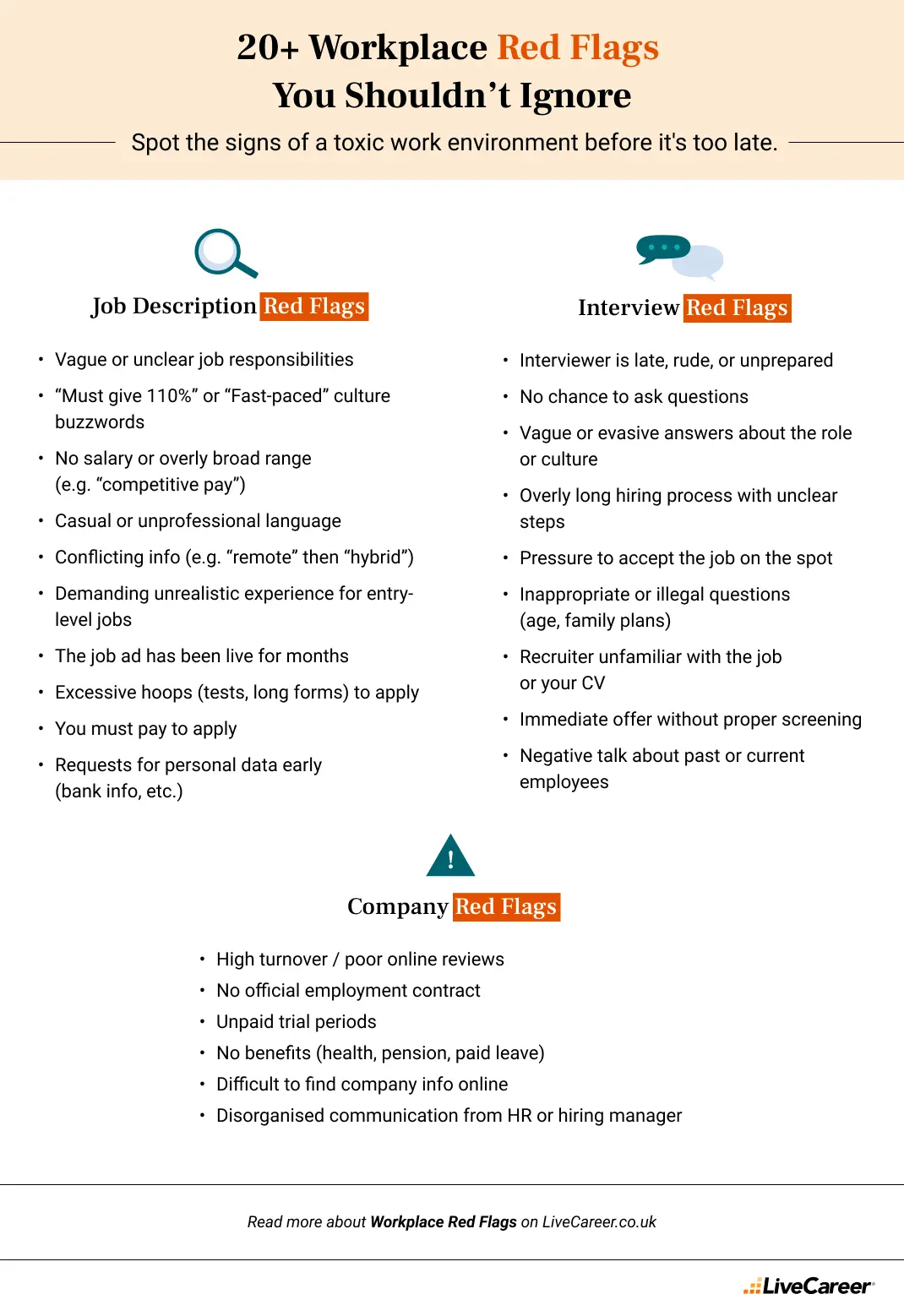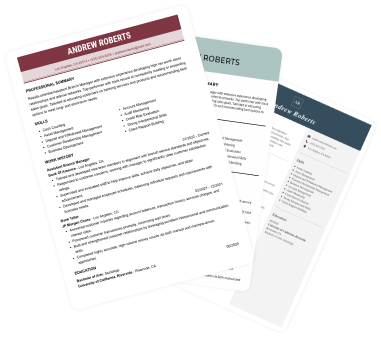
How to Write a Cover Letter in the U.K. (2025)
How to write a cover letter for a job in 2025? This guide offers a step-by-step explanation and actionable tips for writing a cover letter for UK jobs.
November 7, 2025
Last updated on 7 November, 2025

It’s easy to overlook the subtle signs of a toxic work environment, especially when you're excited about a potential role. Yet accepting a position in a toxic workplace can have serious long-term effects on your mental health, career trajectory, and even personal life.
The good news? With the right awareness, you can identify employer red flags well before signing a contract. I’ll help you recognise the signs of a toxic workplace, so you can steer clear of companies that are more harmful than helpful. Let’s begin!
A toxic work environment is characterised by persistent negative behaviours – think bullying, micromanagement, lack of support, and poor communication – that create an atmosphere of fear, stress, or burnout. They don’t offer psychological safety, leaving employees under excessive pressure.
A recent survey of over 2,000 employees across various industries in the UK found that 75% of workers have experienced a toxic work environment. Alarmingly, 87% of those affected reported that the toxic culture had a negative impact on their mental health.
That’s why being able to identify the early signs of a toxic workplace is so crucial. Recognising the signs of a toxic work environment early on empowers you to make smarter choices. The earlier you spot the workplace red flags, the easier it is to walk away and find a healthier, more supportive role.
The first place to look for employer red flags is in the job ad. A job description isn’t just a list of duties – it’s a reflection of how the company views the role and its future employee. Here’s what to watch for:
Phrases like “wear many hats” or “no two days are the same” may sound exciting, but often signal a lack of clear responsibilities. This ambiguity may result in you being pulled in multiple directions without support, often with unrealistic expectations.
When a “junior” position requires a decade of experience and multiple advanced certifications, it's usually a sign that the company wants senior-level results at an entry-level pay. This could also mean the business is poorly resourced and expects employees to fill multiple roles.
Companies that avoid disclosing pay or offer overly broad ranges (e.g. “£25,000–£60,000 DOE”) may be hiding inadequate compensation or internal inequities. Lack of transparency here can reflect broader issues in how they treat and value employees.
Phrases like “fast-paced environment,” “rockstar,” “must thrive under pressure,” or “we’re like a family” often serve as red flags. They can suggest overwork, poor boundaries, lack of professionalism, or cliques.
If the company continually advertises the same position, this may indicate high turnover, internal chaos, or a revolving-door policy where employees are overworked and burned out within a short period.
If a job advert says nothing about training, career progression, or mentorship, it could suggest that the company views employees as disposable rather than investable assets.
An interview is a two-way street: a chance not only for the employer to assess you, but for you to assess them. Pay attention to these signs of a toxic work environment during interviews:
If your interviewer can’t clearly explain the team structure, performance expectations, or growth opportunities, they may be masking dysfunction or a lack of internal planning.
Interviewers who interrupt you, show up late without apology, check their phones, or speak unprofessionally are often reflecting broader issues within the company culture. This behaviour may reflect red flags within the organisation.
If the responsibilities keep changing throughout your interview rounds – or if different people describe the role in conflicting ways – it may suggest confusion, poor leadership, or an unstable work environment.
Be cautious about answering personal questions about your age, marital status, religion, or family plans. These are not just red flags – they're potentially discriminatory and may indicate that diversity and inclusion aren’t valued.
Yes, a cultural fit can be important. But when a company is obsessed with it but cannot define what it means, it may be a code for bias or a cliquish, exclusionary workplace.
If the interviewer speeds through the session or doesn’t give you a chance to ask questions, it may signal they don’t value your input – or worse, don’t want you to dig too deeply.
If you ask why the position is open and the answer is vague or defensive, it could mean the last person quit under difficult circumstances – a classic sign of a toxic workplace.
If you’ve made it through to the offer stage, congratulations! However, don’t let your guard down. Some of the biggest workplace red flags reveal themselves here:
A verbal offer without written confirmation is a major risk. Without documented terms, you’re vulnerable to sudden changes in salary, responsibilities, or benefits.
While skills assessments are normal, asking you to complete unpaid projects that resemble actual work can be exploitative. If they benefit from your output without compensation, that’s a red flag.
No legitimate company should ask for your passport, bank details, or National Insurance number before an official offer is made and accepted.
A company that is unsure of when you’ll start or gives unclear answers about onboarding may be poorly organised or experiencing internal chaos.
Use platforms like Glassdoor or LinkedIn, or even send a polite LinkedIn message to a former employee, to see if the role has had frequent occupants. Constant churn often points to deep-rooted problems.
A company that demands an answer within 24 hours or tries to guilt-trip you into accepting quickly is using pressure tactics. This often reflects desperation, lack of planning, or a coercive management style.
Any employer who minimises paid leave, doesn’t offer sick days, or laughs off questions about mental health support should raise a serious alarm. These are signs of a toxic work environment that fails to prioritise employee wellbeing.

Once you've spotted the signs of a toxic workplace, it’s time to take action to protect your career and mental health. Here’s how:
Review websites like Glassdoor, Indeed, and Reddit. Look for patterns in reviews – one angry ex-employee isn’t enough, but multiple complaints about management, culture, or turnover are telling.
For example:
These can uncover hidden problems and test the company’s willingness to be transparent.
Your experience as a candidate often serves as a preview of what you can expect as an employee. If you’re ghosted, disrespected, or treated with indifference, things likely won’t improve after you start.
Find someone who has worked at the company and ask about their experience. Social media platforms like LinkedIn can help make these informal connections.
If something feels off – whether it’s how you were spoken to, unclear expectations, or a bad vibe – trust yourself. Often, your intuition spots what logic might miss.

Your job is more than just a means to pay the bills. It significantly affects your mental health, relationships, and quality of life. Learning how to identify employer red flags and signs of a toxic work environment empowers you to make informed decisions that protect your well-being and foster professional growth.
While no workplace is perfect, you deserve one where you feel safe, respected, and supported. Don’t let flashy perks, big promises, or desperation to land a job blind you to the realities of a toxic workplace. Sometimes, the best career move you can make is walking away from the wrong offer.
Our editorial team has reviewed this article for compliance with LiveCareer’s editorial guidelines. It’s to ensure that our expert advice and recommendations are consistent across all our career guides and align with current CV and cover letter writing standards and trends. We’re trusted by over 10 million job seekers, supporting them on their way to finding their dream job. Each article is preceded by research and scrutiny to ensure our content responds to current market trends and demand.
Category: Career Advice
Crafting a job-winning CV is all about showcasing your unique skills and experiences. Start with a strong personal statement that highlights your career goals and achievements.
Try Our CV Builder Now